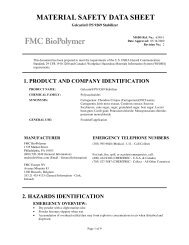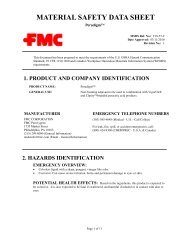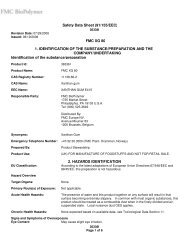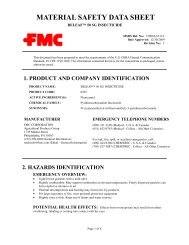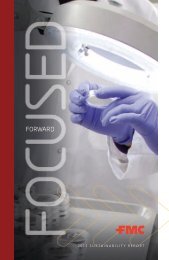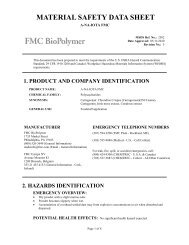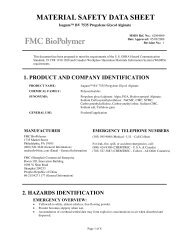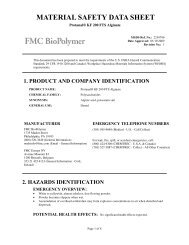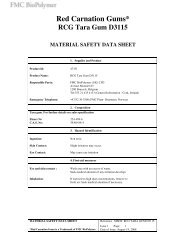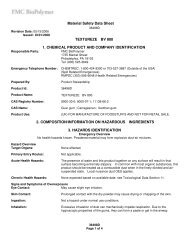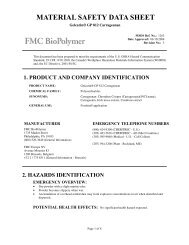Magister(TM) 48EC - FMC Corporation
Magister(TM) 48EC - FMC Corporation
Magister(TM) 48EC - FMC Corporation
Create successful ePaper yourself
Turn your PDF publications into a flip-book with our unique Google optimized e-Paper software.
MATERIAL SAFETY DATA SHEET<br />
<strong>Magister</strong> <strong>48EC</strong><br />
Page 1 of 11<br />
MSDS Ref. No.: 81777-89-1-10<br />
Date Approved: 01/07/2010<br />
Revision No.: 2<br />
This document has been prepared to meet the requirements of the U.S. OSHA Hazard Communication<br />
Standard, 29 CFR 1910.1200 and Canada’s Workplace Hazardous Materials Information System (WHMIS)<br />
requirements.<br />
1. PRODUCT AND COMPANY IDENTIFICATION<br />
PRODUCT NAME: <strong>Magister</strong> <strong>48EC</strong><br />
PRODUCT CODE: 6383<br />
ACTIVE INGREDIENT(S): Clomazone<br />
CHEMICAL FAMILY: Herbicide<br />
SYNONYMS: <strong>FMC</strong> 57020; 2-(2-chlorophenyl)methyl-4,4-dimethyl-3isoxazolidinone;<br />
IUPAC: 2-(2-chlorobenzyl)-4,4-dimethyl-1,2oxazolidin-3-one;2-(2-chlorobenzyl)-4,4-dimethylisoxazolidin-3one<br />
ALTERNATE PRODUCT NAME(S): Command® 480 EC, Command® <strong>48EC</strong>, Commence® <strong>48EC</strong>,<br />
Centium® <strong>48EC</strong><br />
MANUFACTURER<br />
<strong>FMC</strong> CORPORATION<br />
Agricultural Products Group<br />
1735 Market Street<br />
Philadelphia, PA 19103<br />
(215) 299-6000 (General Information)<br />
msdsinfo@fmc.com (Email - General Information)<br />
2. HAZARDS IDENTIFICATION<br />
EMERGENCY TELEPHONE NUMBERS<br />
(800) 331-3148 (Medical - U.S.A. & Canada)<br />
(651) 632-6793 (Medical - Collect - All Other Countries)<br />
For leak, fire, spill, or accident emergencies, call:<br />
(800) 424-9300 (CHEMTREC - U.S.A. & Canada)<br />
(703) 527-3887 (CHEMTREC - Collect - All Other Countries)<br />
EMERGENCY OVERVIEW:<br />
• Straw yellow liquid with an aromatic solvent odor.<br />
• Moderately combustible. May support combustion if heated above the product's flash point (see<br />
Section 9, "Physical and Chemical Properties" below).<br />
• Thermal decomposition and burning may form toxic by-products.<br />
• For large exposures or fire, wear personal protective equipment.<br />
• Slightly to moderately toxic to fish and aquatic organisms. Keep out of drains and water courses.<br />
• Moderately irritating to the eyes.
<strong>Magister</strong> <strong>48EC</strong> (81777-89-1-10) Date: 01/07/2010<br />
POTENTIAL HEALTH EFFECTS: Effects from overexposure result from either<br />
swallowing, inhaling or coming into contact with the eyes or skin. Symptoms of overexposure include<br />
decreased activity, tearing eyes, bleeding from the nose and incoordination.<br />
MEDICAL CONDITIONS AGGRAVATED: None presently known.<br />
3. COMPOSITION / INFORMATION ON INGREDIENTS<br />
Chemical Name CAS# Wt.% EC No. EC Class<br />
Clomazone 81777-89-1 >45 None Xn - N; R20/22-R50/53<br />
Aromatic Hydrocarbons 64742-94-5 35 - 40 265-198-5 Xn; R65<br />
Surfactant Blend
<strong>Magister</strong> <strong>48EC</strong> (81777-89-1-10) Date: 01/07/2010<br />
5. FIRE FIGHTING MEASURES<br />
EXTINGUISHING MEDIA: Foam, CO2 or dry chemical. Soft stream water fog only if<br />
necessary. Contain all runoff.<br />
FIRE / EXPLOSION HAZARDS: Moderately combustible. When heated above the flash<br />
point, this material releases vapors which, when mixed with air, can burn or be explosive.<br />
FIRE FIGHTING PROCEDURES: Isolate fire area. Evacuate downwind. Wear full<br />
protective clothing and self-contained breathing apparatus. Do not breathe smoke, gases or vapors<br />
generated.<br />
6. ACCIDENTAL RELEASE MEASURES<br />
RELEASE NOTES: Isolate and post spill area. Wear protective clothing and personal protective<br />
equipment as prescribed in Section 8, "Exposure Controls/Personal Protection". Keep unprotected persons<br />
and animals out of the area.<br />
Keep material out of lakes, streams, ponds and sewer drains. Dike to confine spill and absorb with a noncombustible<br />
absorbent such as clay, sand or soil. Vacuum, shovel or pump waste into a drum and label<br />
contents for disposal.<br />
To clean and neutralize tools and equipment, wash with a 20% solution of potassium hydroxide in<br />
methanol. Follow by washing with strong soap and rinsing with water, and add both solutions to the drums<br />
of waste already collected.<br />
To clean and neutralize spill areas, spray the area with a 20% solution of potassium hydroxide in methanol.<br />
Cover the treated area with plastic and let stand for 24 hours. Remove the covering and place in a drum for<br />
later disposal. Wash the area, three times, with a strong soap and rinse with water. If spill occurs on a<br />
wooden surface, repeat the entire process again. Absorb, as above, any excess liquid and add to the drums<br />
of waste already collected. Dispose of drummed waste according to the method outlined in Section 13,<br />
"Disposal Considerations".<br />
7. HANDLING AND STORAGE<br />
HANDLING AND STORAGE: Store in a cool, dry, well-ventilated place. Do not use or<br />
store near heat, open flame or hot surfaces. Store in original containers only. Keep out of reach of children<br />
and animals. Do not contaminate other pesticides, fertilizers, water, food or feed by storage or disposal.<br />
Page 3 of 11
<strong>Magister</strong> <strong>48EC</strong> (81777-89-1-10) Date: 01/07/2010<br />
8. EXPOSURE CONTROLS / PERSONAL PROTECTION<br />
EXPOSURE LIMITS<br />
Chemical Name ACGIH OSHA Supplier<br />
Aromatic<br />
Hydrocarbons<br />
Naphthalene<br />
1,2,4-trimethylbenzene<br />
10 ppm (TWA)<br />
15 ppm (STEL)<br />
25 ppm (TWA)<br />
Page 4 of 11<br />
10 ppm (PEL)<br />
50 mg/m 3 (PEL)<br />
18 ppm<br />
ENGINEERING CONTROLS: Use local exhaust at all process locations where vapor or<br />
mist may be emitted. Ventilate all transport vehicles prior to unloading.<br />
PERSONAL PROTECTIVE EQUIPMENT<br />
EYES AND FACE: For splash, mist, vapor or dust exposure wear chemical protective<br />
goggles or a face shield.<br />
RESPIRATORY: For splash, mist or spray exposures wear, as a minimum, a properly<br />
fitted half-face or full-face air-purifying respirator which is approved for pesticides (U.S.<br />
NIOSH/MSHA, EU CEN or comparable certification organization). Respirator use and selection<br />
must be based on airborne concentrations.<br />
PROTECTIVE CLOTHING: Depending upon concentrations encountered, wear<br />
coveralls or long-sleeved uniform and head covering. For larger exposures as in the case of spills,<br />
wear full body cover barrier suit, such as a PVC suit. Leather items - such as shoes, belts and<br />
watchbands - that become contaminated should be removed and destroyed. Launder all work<br />
clothing before reuse (separately from household laundry).<br />
GLOVES: Wear chemical protective gloves made of materials such as rubber or nitrile.<br />
Thoroughly wash the outside of gloves with soap and water prior to removal. Inspect regularly for<br />
leaks.<br />
WORK HYGIENIC PRACTICES: Clean water should be available for washing in case of<br />
eye or skin contamination. Wash skin prior to eating, drinking, chewing gum, or using tobacco. Shower at<br />
the end of the workday.
<strong>Magister</strong> <strong>48EC</strong> (81777-89-1-10) Date: 01/07/2010<br />
9. PHYSICAL AND CHEMICAL PROPERTIES<br />
ODOR: Aromatic solvent<br />
APPEARANCE: Straw yellow liquid<br />
DENSITY / WEIGHT PER VOLUME: 1.018 - 1.038 g/cm 3<br />
FLASH POINT: 65 °C (149 °F)<br />
pH: 6 - 7 (5% solution)<br />
SOLUBILITY IN WATER: Not available<br />
SPECIFIC GRAVITY: > 1 @ 20 °C<br />
VAPOR PRESSURE: Not available<br />
10. STABILITY AND REACTIVITY<br />
CONDITIONS TO AVOID: Excessive heat and fire.<br />
STABILITY: Stable<br />
POLYMERIZATION: Will not occur<br />
INCOMPATIBLE MATERIALS: Strong oxidizers<br />
HAZARDOUS DECOMPOSITION PRODUCTS: Carbon monoxide and/or carbon dioxide, oxides of<br />
nitrogen, chlorine and hydrogen chloride.<br />
11. TOXICOLOGICAL INFORMATION<br />
EYE EFFECTS: No data available for the formulation.<br />
Clomazone: Non-irritating (rabbit)<br />
SKIN EFFECTS: No data available for the formulation.<br />
Clomazone: Minimally irritating (rabbit)<br />
DERMAL LD50: No data available.<br />
Similar product: > 2,000 mg/kg (rabbit)<br />
ORAL LD50: No data available.<br />
Clomazone: 1,369 mg/kg (rat)<br />
INHALATION LC50: No data available.<br />
Clomazone: 4.85 mg/l (4 h) (rat)<br />
Page 5 of 11
<strong>Magister</strong> <strong>48EC</strong> (81777-89-1-10) Date: 01/07/2010<br />
ACUTE EFFECTS FROM OVEREXPOSURE: This product is expected to have low<br />
oral, dermal and inhalation toxicity. It is expected to be moderately irritating to the eyes and slightly<br />
irritating to the skin. Large dosages of clomazone ingested by laboratory animals produced signs of toxicity<br />
including ataxia, decreased activity, oral discharge, lacrimation, bloody tears, and nasal discharge.<br />
Inhalation of aromatic hydrocarbon vapors may cause dizziness, disturbances in vision, drowsiness,<br />
respiratory irritation, and eye, skin and mucous membrane irritation. Vomiting after ingestion of this<br />
product may cause aspiration of aromatic hydrocarbons into the lungs, which may result in fatal pulmonary<br />
edema.<br />
CHRONIC EFFECTS FROM OVEREXPOSURE: No data available for the<br />
formulation. In studies with laboratory animals, clomazone did not cause reproductive toxicity,<br />
teratogenicity, or carcinogenicity. Liver enlargement and elevated cholesterol levels are often noted in<br />
laboratory animals that have ingested large doses of clomazone during their lifespan. An overall absence of<br />
genotoxicity has been demonstrated in tests of mutagenicity, DNA damage and chromosome aberrations.<br />
Chronic exposure to aromatic hydrocarbons may cause headaches, dizziness, loss of sensations or feelings<br />
(such as numbness), and liver and kidney damage. Chronic exposure to trimethylbenzenes may cause CNS<br />
changes, asthmatic bronchitis and blood dyscrasias.<br />
CARCINOGENICITY:<br />
Chemical Name IARC NTP OSHA Other<br />
Naphthalene 2B Anticipated<br />
Carcinogen<br />
Not listed (ACGIH) Not listed<br />
12. ECOLOGICAL INFORMATION<br />
Unless otherwise indicated, the data presented below are for the active ingredient(s).<br />
ENVIRONMENTAL DATA: No data available for the formulation.<br />
Clomazone has a moderate rate of degradation in soil (half-life = 24 days), and is stable to hydrolysis over a<br />
wide range of pH. The bioconcentration potential for clomazone is low, with a Log Pow of 2.5, and a<br />
measured bioconcentration factor (BCF) of 27 - 40. Field studies showed that clomazone does not<br />
significantly leach below 15 cm in soil and is, therefore, not expected to enter groundwater.<br />
ECOTOXICOLOGICAL INFORMATION: No data available for the formulation.<br />
Clomazone technical:<br />
Freshwater fish: 96-hour LC50 = 19 mg/L (Rainbow trout) (slightly toxic)<br />
Freshwater fish: 96-hour LC50 = 34 mg/L (Bluegill sunfish) (slightly toxic)<br />
Estuarine invertebrates: 96-hour LC50 = 8.9 mg/L (Pink shrimp) (moderately toxic)<br />
Estuarine fish: LC50 = 6.3 mg/L (Atlantic silverside, moderately toxic) - 41 mg/L (Sheepshead minnow,<br />
slightly toxic)<br />
Estuarine invertebrate: LC50 = 0.57 mg/L (Mysid) (highly toxic)<br />
Waterfowl / Upland game birds: Oral LD50 >2510 mg/kg; Dietary LC50 >5620 ppm (low toxicity)<br />
Care should be taken to avoid contamination of the aquatic environment.<br />
Page 6 of 11
<strong>Magister</strong> <strong>48EC</strong> (81777-89-1-10) Date: 01/07/2010<br />
13. DISPOSAL CONSIDERATIONS<br />
DISPOSAL METHOD: Open dumping or burning of this material or its packaging is prohibited.<br />
If spilled material cannot be disposed of by use according to label instructions, an acceptable method of<br />
disposal is to incinerate in accordance with local, state and national environmental laws, rules, standards<br />
and regulations. However, because acceptable methods of disposal may vary by location and regulatory<br />
requirements may change, the appropriate agencies should be contacted prior to disposal.<br />
EMPTY CONTAINER: Non-returnable containers that held this material should be cleaned,<br />
prior to disposal, by triple rinsing. Containers which held this material may be cleaned by being triplerinsed,<br />
and recycled, with the rinsate being incinerated. Do not cut or weld metal containers. Vapors that<br />
form may create an explosion hazard.<br />
14. TRANSPORT INFORMATION<br />
U.S. DEPAR<strong>TM</strong>ENT OF TRANSPORTATION (DOT)<br />
PACKAGING TYPE: Non-Bulk<br />
ADDITIONAL INFORMATION: This material is not a hazardous material as<br />
defined by US Department of<br />
Transportation at 49 CFR Parts 100 through<br />
185.<br />
PACKAGING TYPE: Bulk<br />
PROPER SHIPPING NAME: Combustible liquid, n.o.s.<br />
TECHNICAL NAME(S): Naphthalene<br />
PRIMARY HAZARD CLASS / DIVISION: Combustible liquid<br />
UN/NA NUMBER: NA 1993<br />
PACKING GROUP: III<br />
MARINE POLLUTANT: Clomazone, Naphthalene<br />
MARKING(S): NA 1993 + Marine Pollutant<br />
REPORTABLE QUANTITY (RQ): Naphthalene<br />
ADDITIONAL INFORMATION: Naphthalene is in an "RQ" quantity when<br />
this material meets or exceeds 2,000 pounds<br />
per bulk package.<br />
Page 7 of 11
<strong>Magister</strong> <strong>48EC</strong> (81777-89-1-10) Date: 01/07/2010<br />
INTERNATIONAL MARITIME DANGEROUS GOODS (IMDG)<br />
PACKAGING TYPE: Non-Bulk<br />
PROPER SHIPPING NAME: Environmentally hazardous substance,<br />
liquid, n.o.s.<br />
TECHNICAL NAME(S): Clomazone, Naphthalene<br />
PRIMARY HAZARD CLASS / DIVISION: 9<br />
UN/NA NUMBER: UN 3082<br />
PACKING GROUP: III<br />
MARINE POLLUTANT: Clomazone, Naphthalene<br />
LABEL(S): 9<br />
PLACARD(S): 9<br />
MARKING(S): Environmentally hazardous substance,<br />
liquid, n.o.s., (clomazone, naphthalene),<br />
UN 3082 + Marine Pollutant<br />
ADDITIONAL INFORMATION: EmS Number: F-A, S-F<br />
ADR - EUROPEAN AGREEMENT CONCERNING THE<br />
INTERNATIONAL CARRIAGE OF DANGEROUS GOODS BY ROAD<br />
PACKAGING TYPE: Non-Bulk<br />
PROPER SHIPPING NAME: Environmentally hazardous substance,<br />
liquid, n.o.s.<br />
TECHNICAL NAME(S): Clomazone, Naphthalene<br />
PRIMARY HAZARD CLASS / DIVISION: 9<br />
CLASSIFICATION CODE: M6<br />
UN/NA NUMBER: UN3082<br />
PACKING GROUP: III<br />
HAZARD IDENTIFICATION NUMBER: 90<br />
MARINE POLLUTANT: Clomazone, Naphthalene<br />
LABEL(S): 9<br />
PLACARD(S): 9<br />
MARKING(S): UN 3082 + Marine Pollutant<br />
Page 8 of 11
<strong>Magister</strong> <strong>48EC</strong> (81777-89-1-10) Date: 01/07/2010<br />
INTERNATIONAL CIVIL AVIATION ORGANIZATION (ICAO) /<br />
INTERNATIONAL AIR TRANSPORT ASSOCIATION (IATA)<br />
PACKAGING TYPE: Non-Bulk<br />
PROPER SHIPPING NAME: Environmentally hazardous substance,<br />
liquid, n.o.s.<br />
TECHNICAL NAME(S): Clomazone, Naphthalene<br />
PRIMARY HAZARD CLASS / DIVISION: 9<br />
UN/NA NUMBER: UN3082<br />
PACKING GROUP: III<br />
LABEL(S): 9<br />
ADDITIONAL INFORMATION: Marks: Environmentally hazardous<br />
substance, liquid, n.o.s. (clomazone,<br />
naphthalene ), UN3082 + Marine Pollutant<br />
OTHER INFORMATION:<br />
CANADIAN TRANSPORT (TDG):<br />
ADDITIONAL INFORMATION: This material is not a dangerous good as defined by TDG Regulations.<br />
15. REGULATORY INFORMATION<br />
UNITED STATES<br />
SARA TITLE III (SUPERFUND AMENDMENTS AND REAUTHORIZATION ACT)<br />
SECTION 302 EXTREMELY HAZARDOUS SUBSTANCES (40 CFR 355, APPENDIX A):<br />
Not listed<br />
SECTION 311 HAZARD CATEGORIES (40 CFR 370):<br />
Immediate, Delayed, Fire<br />
SECTION 312 THRESHOLD PLANNING QUANTITY (40 CFR 370):<br />
The Threshold Planning Quantity (TPQ) for this product, if treated as a mixture, is 10,000 lbs;<br />
however, this product contains the following ingredients with a TPQ of less than 10,000 lbs.:<br />
None<br />
SECTION 313 REPORTABLE INGREDIENTS (40 CFR 372):<br />
This product contains the following ingredients subject to Section 313 reporting requirements:<br />
Naphthalene<br />
Page 9 of 11
<strong>Magister</strong> <strong>48EC</strong> (81777-89-1-10) Date: 01/07/2010<br />
CERCLA (COMPREHENSIVE ENVIRONMENTAL RESPONSE COMPENSATION AND<br />
LIABILITY ACT)<br />
CERCLA DESIGNATION & REPORTABLE QUANTITIES (RQ) (40 CFR 302.4):<br />
As noted below:<br />
Chemical Name RQ<br />
Naphthalene 100 lb<br />
U.S. STATES<br />
CANADA<br />
California Prop 65:<br />
WARNING: This product contains a chemical known to the State of California to cause<br />
cancer, birth defects or other reproductive harm.<br />
WHMIS (WORKPLACE HAZARDOUS MATERIALS INFORMATION SYSTEM):<br />
This product has been classified in accordance with the hazard criteria of the Controlled Products<br />
Regulations and the MSDS contains all the information required by the Controlled Products<br />
Regulations.<br />
Hazard Classification / Division: B3<br />
D2A<br />
D2B<br />
Domestic Substance List: All components are listed or exempt.<br />
16. OTHER INFORMATION<br />
NFPA<br />
Health 2<br />
Flammability 2<br />
Reactivity 0<br />
Special<br />
NFPA (National Fire Protection Association)<br />
Degree of Hazard Code:<br />
4 = Extreme<br />
3 = High<br />
2 = Moderate<br />
1 = Slight<br />
0 = Insignificant<br />
REVISION SUMMARY:<br />
Page 10 of 11
<strong>Magister</strong> <strong>48EC</strong> (81777-89-1-10) Date: 01/07/2010<br />
This MSDS replaces Revision #1, dated December 19, 2007.<br />
Changes in information are as follows:<br />
Section 3 (Composition / Information on Ingredients)<br />
Section 8 (Exposure Controls / Personal Protection)<br />
Section 14 (Transport Information)<br />
Section 16 (Other Information)<br />
<strong>Magister</strong>, Command, Commence, Centium and <strong>FMC</strong> Logo - <strong>FMC</strong> Trademarks<br />
© 2010 <strong>FMC</strong> <strong>Corporation</strong>. All Rights Reserved.<br />
<strong>FMC</strong> <strong>Corporation</strong> believes that the information and recommendations contained herein (including data and<br />
statements) are accurate as of the date hereof. NO WARRANTY OF FITNESS FOR ANY PARTICULAR<br />
PURPOSE, WARRANTY OF MERCHANTABILITY, OR ANY OTHER WARRANTY, EXPRESSED<br />
OR IMPLIED, IS MADE CONCERNING THE INFORMATION PROVIDED HEREIN. The information<br />
provided herein relates only to the specific product designated and may not be applicable where such<br />
product is used in combination with any other materials or in any process. It is a violation of Federal law to<br />
use this product in a manner inconsistent with its labeling. Further, since the conditions and methods of use<br />
are beyond the control of <strong>FMC</strong> <strong>Corporation</strong>, <strong>FMC</strong> <strong>Corporation</strong> expressly disclaims any and all liability as<br />
to any results obtained or arising from any use of the product or reliance on such information.<br />
Page 11 of 11



